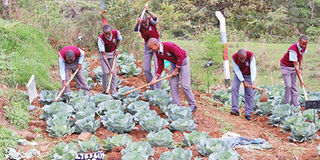The school that is feeding itself

Anestar Boys high schools students on their farm in Nakuru. PHOTO| FRANCIS MUREITHI|NMG
What you need to know:
- Anestar Boys High School in Lanet, some 13 kilometres from Nakuru Town, sits near the depleted Dundori Forest.
- The school also keeps birds, mainly 300 Kienyeji chickens and turkeys.
The project has helped to change the perception of students on agriculture.
Anestar Boys High School in Lanet, some 13 kilometres from Nakuru Town, sits near the depleted Dundori Forest.
Sukuma wiki (collard greens), cabbages and potatoes are some of the crops that are flourishing on the school farm.
Seeds of Gold team finds students working on the farm, some weeding their vegetables and others feeding rabbits and pigs.
“I came to this school with zero knowledge on rabbit rearing but I have learnt a lot as an agriculture student. I know the various breeds of rabbits, their feeding regime and disease management,” says Mwaura, a Form Four student.
Rabbit breeds
He lists the rabbit breeds as California white, Flemish giant and Chinchilla, but the students keep the first two, as he also isolates pneumonia as among diseases that attack rabbits.
“We feed the rabbits hay, fresh vegetables from our farm, fruits and pellets. We then use their manure to enrich the soil,” says principal Marcos Ogachi.
The school also keeps birds, mainly 300 Kienyeji chickens and turkeys.
They also have 30 pigs, 20 Friesian cows and several goats and sheep.
“We get 30 litres of milk daily from the three animals that are lactating. The students consume all of it,” says Ogachi, adding they slaughter a pig every week for the learners.
Surplus income
Ogachi notes the farming projects in which they ploughed Sh500,000 generate for the school up to Sh100,000 per month and have employed some 15 workers.
“The school buys the pigs at between Sh10,000 and Sh30,000 depending on the weight. We feed our more than 900 students with produce from the farm and get some income and at the same time give the students first-hand experience in agriculture,” says Ogachi.
Surplus money is used to expand the project and support needy students who are not able to raise fees.
He says initially, the students had challenges accessing water but the school has drilled a borehole.
“We had challenges with a vet but we have now employed one to look after the welfare of the animals and the birds,” adds Ogachi.
Change of perception
The project has helped to change the perception of students on agriculture.
“They have learnt that agriculture is not a dirty job. Most of our students are from urban settings and some had not touched a pig or slaughtered a chicken in their lifetime. They are now getting real-life experience,” observes Ogachi.
The project helped lift the agriculture mean score to 9.2 last year, according to the principal, with the subject being among those that recorded impressive grades at the institution.
Nakuru Agriculture executive Immaculate Maina notes most of the students who start engaging in farming early tend to love agribusiness and promote it in future.
“With the diminishing white-collar jobs, and the innovative minds of young farmers, agriculture should be a compulsory subject as students could translate the learning to create self-employment opportunities for themselves and their peers once they finish school and colleges,” says Dr Maina.





